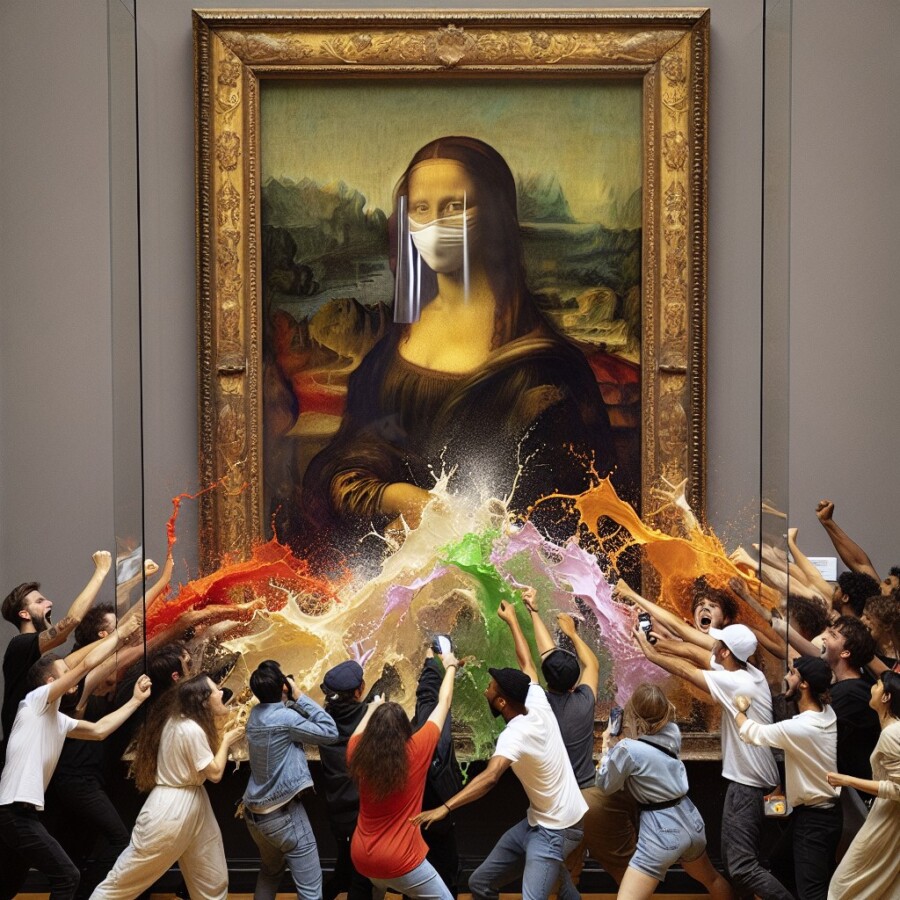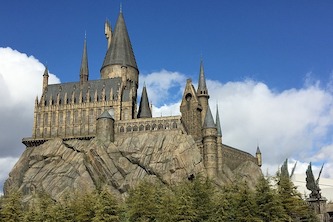Protesters recently made headlines for throwing soup at the famous Mona Lisa painting in Paris. The painting, created by Leonardo da Vinci in the 16th century, is displayed in the Louvre, a well-known art museum. Despite the incident, the painting is protected by bulletproof glass, keeping it safe from any serious harm.
The protesters who threw soup at the Mona Lisa wanted to bring attention to the need for better access to healthy and sustainable food. They were unhappy with how food is currently produced and distributed. Their goal was to highlight issues with the quality and sustainability of the food supply chain.
The Mona Lisa is famous for her mysterious smile and is a symbol of artistic excellence and cultural heritage. People from all over the world are drawn to the painting because of its significance that goes beyond time and place. Even though the soup-throwing incident was shocking, the painting was not damaged and continues to attract visitors.
This event shows how art can stir up reactions and start conversations about important social issues. While throwing soup at a respected artwork might seem extreme, it reminds us of how art can reflect and challenge the norms of society. The incident has sparked discussions about the limits of protest and the right ways to advocate for change.
Original news source: Watch: Soup thrown at Mona Lisa painting (BBC)
🎧 Listen:
Slow
Normal
Fast
📖 Vocabulary:
| 1 | protesters | People who show they disagree with something by standing somewhere, shouting, holding signs, etc. |
| 2 | sustainable | Able to be maintained or continued without causing harm to the environment or using up resources permanently. |
| 3 | incident | An event, especially one that is bad or unusual. |
| 4 | bulletproof | Made of or covered with a material that can stop bullets from going through. |
| 5 | highlight | To draw attention to something important. |
| 6 | distributed | To give out things to a number of people. |
| 7 | mysterious | Difficult to understand or explain; not known. |
| 8 | symbol | Something that stands for or represents something else, especially something important. |
| 9 | significance | The importance or meaning of something. |
| 10 | attract | To cause something to come towards something else because of some quality it has. |
| 11 | reactions | The feelings or actions of people in response to something. |
| 12 | extreme | Going far beyond what is reasonable or typical. |
| 13 | reflect | To show a likeness or image of something. |
| 14 | challenge | To test the strength or beliefs of something or someone. |
| 15 | advocate | To support or argue for (a cause or policy). |
Group or Classroom Activities
Warm-up Activities:
– News Summary
Instructions: Divide the class into pairs. Give each pair a few minutes to read the article. Then, ask each pair to summarize the main points of the article in 3-4 sentences. Have pairs take turns sharing their summaries with the class.
– Opinion Poll
Instructions: Write the following question on the board: “Do you think throwing soup at the Mona Lisa was an effective way to bring attention to social issues?” Give students a few minutes to think about their opinion and reasons behind it. Then, have them stand up and find a partner to discuss their opinion. After the discussion, conduct a class poll by asking students to raise their hands for “yes” or “no” to the question. Encourage students to share their reasons for their opinion.
– Sketch It
Instructions: Divide the class into small groups. Give each group a large piece of paper and markers. Instruct the groups to create a visual representation of the article using drawings and symbols. Encourage them to be creative and think about how they can visually depict the main ideas and themes of the article. After a designated time, have each group present their sketches to the class and explain their choices.
– Vocabulary Pictionary
Instructions: Write a list of vocabulary words from the article on the board. Divide the class into two teams. One person from each team will come to the front of the class and take turns choosing a word from the list. They must then draw or act out the word for their team to guess. The team that guesses correctly earns a point. Continue until all the words have been used or for a designated amount of time. The team with the most points at the end wins.
– Future Predictions
Instructions: In pairs, have students discuss and make predictions about the potential consequences of the soup-throwing incident on the art world and society in general. Encourage them to think about how this event might impact the way art is protected and viewed, as well as the way protests are conducted. After the discussion, have pairs share their predictions with the class. Encourage students to provide reasons and evidence for their predictions.
🤔 Comprehension Questions:
1. What happened to the Mona Lisa painting in Paris?
2. Who created the Mona Lisa painting?
3. Where is the painting displayed?
4. Why did the protesters throw soup at the Mona Lisa?
5. What did the protesters want to bring attention to?
6. What is the Mona Lisa famous for?
7. Was the painting damaged by the soup-throwing incident?
8. What can this event teach us about the power of art?
Go to answers ⇩
🎧✍️ Listen and Fill in the Gaps:
Protesters recently made headlines for throwing soup at the famous Mona Lisa (1)______ in Paris. The painting, created by Leonardo da Vinci in the 16th century, is (2)______ in the Louvre, a well-known art (3)______. Despite the incident, the painting is protected by bulletproof glass, (4)______ it safe from any serious harm.
The protesters who threw soup at the Mona Lisa wanted to bring attention to the need for (5)______ access to healthy and sustainable food. They were unhappy with how food is currently produced and distributed. Their goal was to (6)______ issues with the (7)______ and (8)______ of the food supply chain.
The Mona Lisa is famous for her mysterious smile and is a symbol of artistic excellence and (9)______ heritage. People from all over the (10)______ are (11)______ to the painting because of its significance that goes beyond time and place. Even though the soup-throwing incident was shocking, the painting was not damaged and continues to attract visitors.
This (12)______ shows how art can stir up (13)______ and start conversations about important social issues. While (14)______ soup at a (15)______ artwork might seem extreme, it reminds us of how art can reflect and challenge the norms of society. The incident has sparked discussions about the (16)______ of protest and the right ways to advocate for change.
Go to answers ⇩
💬 Discussion Questions:
Students can ask a partner these questions, or discuss them as a group.
1. What is the Mona Lisa?
2. How would you feel if someone threw soup at a famous painting?
3. Do you think it is important to have better access to healthy and sustainable food? Why or why not?
4. What do you think about the quality and sustainability of the food supply chain in your country?
5. Why do you think the Mona Lisa is such a famous painting?
6. Have you ever visited an art museum? If so, which one and what did you see?
7. Do you think art can be a powerful tool for starting conversations about important social issues? Why or why not?
8. What are some other ways people can advocate for change besides throwing soup at a painting?
9. How do you think society should respond to extreme forms of protest like this one?
10. Have you ever participated in a protest or demonstration? If so, what was it about and why did you choose to participate?
11. Do you think it is important to preserve cultural heritage? Why or why not?
12. How do you think the soup-throwing incident affected the reputation of the protesters’ cause?
13. Do you believe that art should be protected and preserved at all costs? Why or why not?
14. What other forms of art do you think can provoke strong reactions or start important conversations?
15. How can we find a balance between expressing our opinions and respecting the rights of others?
Individual Activities
📖💭 Vocabulary Meanings:
Match each word to its meaning.
Words:
1. protesters
2. sustainable
3. incident
4. bulletproof
5. highlight
6. distributed
7. mysterious
8. symbol
9. significance
10. attract
11. reactions
12. extreme
13. reflect
14. challenge
15. advocate
Meanings:
(A) Something that stands for or represents something else, especially something important.
(B) Difficult to understand or explain; not known.
(C) To test the strength or beliefs of something or someone.
(D) To support or argue for (a cause or policy).
(E) Made of or covered with a material that can stop bullets from going through.
(F) Able to be maintained or continued without causing harm to the environment or using up resources permanently.
(G) To give out things to a number of people.
(H) To draw attention to something important.
(I) Going far beyond what is reasonable or typical.
(J) People who show they disagree with something by standing somewhere, shouting, holding signs, etc.
(K) An event, especially one that is bad or unusual.
(L) The importance or meaning of something.
(M) The feelings or actions of people in response to something.
(N) To show a likeness or image of something.
(O) To cause something to come towards something else because of some quality it has.
Go to answers ⇩
🔡 Multiple Choice Questions:
1. Where is the Mona Lisa painting displayed?
(a) MoMA
(b) Tate Modern
(c) Guggenheim
(d) Louvre
2. Who created the Mona Lisa painting?
(a) Vincent van Gogh
(b) Pablo Picasso
(c) Michelangelo
(d) Leonardo da Vinci
3. What did the protesters throw at the Mona Lisa?
(a) Soup
(b) Paint
(c) Water
(d) Confetti
4. What was the protesters’ goal in throwing soup at the Mona Lisa?
(a) Promote a new restaurant
(b) Protest against art museums
(c) Highlight food supply chain issues
(d) Support local farmers
5. What is the Mona Lisa famous for?
(a) Mysterious smile
(b) Bright colors
(c) Abstract shapes
(d) Historical scenes
6. What did the bulletproof glass protect the Mona Lisa from?
(a) Sunlight
(b) Serious harm
(c) Theft
(d) Dust
7. What does the article say about the significance of the Mona Lisa?
(a) Is only popular in France
(b) Is a recent creation
(c) Goes beyond time and place
(d) Has no cultural importance
8. What did the soup-throwing incident spark discussions about?
(a) Best soup recipes
(b) Limits of protest
(c) Louvre’s security
(d) Mona Lisa’s smile dimensions
Go to answers ⇩
🕵️ True or False Questions:
1. The Mona Lisa was created by Leonardo da Vinci in the 16th century and is displayed in the Louvre.
2. The event sparked discussions about art’s role in addressing social issues.
3. The painting repels people worldwide due to its lack of cultural significance.
4. The protesters wanted to raise awareness about unhealthy and unsustainable food access.
5. The Mona Lisa is known for her straightforward smile and is a symbol of artistic mediocrity.
6. Protesters recently threw soup at the unknown Mona Lisa painting in Paris.
7. Despite the soup-throwing incident, the Mona Lisa remains undamaged.
8. The painting is protected by bulletproof glass, so it wasn’t seriously harmed.
Go to answers ⇩
📝 Write a Summary:
Write a summary of this news article in two sentences.
Check your writing now with the best free AI for English writing!
Writing Questions:
Answer the following questions. Write as much as you can for each answer.
Check your answers with our free English writing assistant!
1. What did the protesters do to the Mona Lisa painting?
2. How did the bulletproof glass protect the painting?
3. Why were the protesters unhappy with the current food production and distribution?
4. What is the Mona Lisa famous for?
5. What does the soup-throwing incident show about the power of art?
✅ Answers
🤔✅ Comprehension Question Answers:
1. What happened to the Mona Lisa painting in Paris?
Protesters threw soup at the Mona Lisa painting in Paris.
2. Who created the Mona Lisa painting?
The Mona Lisa painting was created by Leonardo da Vinci.
3. Where is the painting displayed?
The painting is displayed in the Louvre, a well-known art museum in Paris.
4. Why did the protesters throw soup at the Mona Lisa?
The protesters threw soup at the Mona Lisa to bring attention to the need for better access to healthy and sustainable food.
5. What did the protesters want to bring attention to?
The protesters wanted to bring attention to issues with the quality and sustainability of the food supply chain.
6. What is the Mona Lisa famous for?
The Mona Lisa is famous for her mysterious smile and is a symbol of artistic excellence and cultural heritage.
7. Was the painting damaged by the soup-throwing incident?
No, the painting was not damaged by the soup-throwing incident.
8. What can this event teach us about the power of art?
This event teaches us that art can stir up reactions and start conversations about important social issues. It reminds us of how art can reflect and challenge the norms of society.
Go back to questions ⇧
🎧✍️✅ Listen and Fill in the Gaps Answers:
(1) painting
(2) displayed
(3) museum
(4) keeping
(5) better
(6) highlight
(7) quality
(8) sustainability
(9) cultural
(10) world
(11) drawn
(12) event
(13) reactions
(14) throwing
(15) respected
(16) limits
Go back to questions ⇧
📖💭✅ Vocabulary Meanings Answers:
1. protesters
Answer: (J) People who show they disagree with something by standing somewhere, shouting, holding signs, etc.
2. sustainable
Answer: (F) Able to be maintained or continued without causing harm to the environment or using up resources permanently.
3. incident
Answer: (K) An event, especially one that is bad or unusual.
4. bulletproof
Answer: (E) Made of or covered with a material that can stop bullets from going through.
5. highlight
Answer: (H) To draw attention to something important.
6. distributed
Answer: (G) To give out things to a number of people.
7. mysterious
Answer: (B) Difficult to understand or explain; not known.
8. symbol
Answer: (A) Something that stands for or represents something else, especially something important.
9. significance
Answer: (L) The importance or meaning of something.
10. attract
Answer: (O) To cause something to come towards something else because of some quality it has.
11. reactions
Answer: (M) The feelings or actions of people in response to something.
12. extreme
Answer: (I) Going far beyond what is reasonable or typical.
13. reflect
Answer: (N) To show a likeness or image of something.
14. challenge
Answer: (C) To test the strength or beliefs of something or someone.
15. advocate
Answer: (D) To support or argue for (a cause or policy).
Go back to questions ⇧
🔡✅ Multiple Choice Answers:
1. Where is the Mona Lisa painting displayed?
Answer: (d) Louvre
2. Who created the Mona Lisa painting?
Answer: (d) Leonardo da Vinci
3. What did the protesters throw at the Mona Lisa?
Answer: (a) Soup
4. What was the protesters’ goal in throwing soup at the Mona Lisa?
Answer: (c) Highlight food supply chain issues
5. What is the Mona Lisa famous for?
Answer: (a) Mysterious smile
6. What did the bulletproof glass protect the Mona Lisa from?
Answer: (b) Serious harm
7. What does the article say about the significance of the Mona Lisa?
Answer: (c) Goes beyond time and place
8. What did the soup-throwing incident spark discussions about?
Answer: (b) Limits of protest
Go back to questions ⇧
🕵️✅ True or False Answers:
1. The Mona Lisa was created by Leonardo da Vinci in the 16th century and is displayed in the Louvre. (Answer: True)
2. The event sparked discussions about art’s role in addressing social issues. (Answer: True)
3. The painting repels people worldwide due to its lack of cultural significance. (Answer: False)
4. The protesters wanted to raise awareness about unhealthy and unsustainable food access. (Answer: False)
5. The Mona Lisa is known for her straightforward smile and is a symbol of artistic mediocrity. (Answer: False)
6. Protesters recently threw soup at the unknown Mona Lisa painting in Paris. (Answer: False)
7. Despite the soup-throwing incident, the Mona Lisa remains undamaged. (Answer: True)
8. The painting is protected by bulletproof glass, so it wasn’t seriously harmed. (Answer: True)
Go back to questions ⇧













